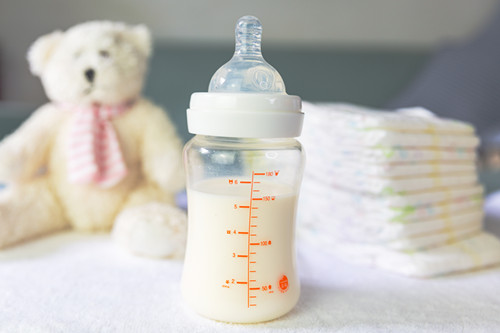On March 27, 2025, Chinese NHC released 50 new national food safety standards, including GB 25596-2025: National Food Safety Standard – General Principles for FSMP Infant Formula. The transition period for this new standard, based on previous regulations and a comprehensive evaluation of various factors, has been set at two years. It will officially come into effect on March 16, 2027.

CIRS conducted a comparison analysis between the new 2025 standard and the current 2010 version. The main changes are summarized as follows:
1. Revised requirements for basic nutrients
Drawing from GB 10765-2021 (Infant Formula) and GB 10766-2021 (Follow-up Formula), the requirements for essential and optional ingredients have been revised to ensure scientific, safe, and effective nutritional support in the products.
2. Restricted sources of carbohydrates
In addition to the previously banned use of fructose, sucrose is now also prohibited as a carbohydrate source. Except under special conditions (e.g., lactose intolerance), lactose should be the preferred carbohydrate, and glucose polymers may be added as appropriate (only pre-gelatinized starch is allowed).
3. Improved technical requirements for existing product categories
The main technical requirements for formulas listed in Appendix A of the previous standard, along with corresponding Q&A content, have been integrated and revised based on the latest scientific evidence.
4. Introduction of new product categories
- To further meet clinical and consumer needs, six new FSMP product categories have been added.
5. Revised specific indicators for amino acids in Appendix B
In line with the Announcement on the Management of Amino Acids in Special Dietary Foods (No. 11, 2023) by the NHC and SAMR, specific chemical names and molecular formulas for amino acids listed in Table B.1 of Appendix B have been removed. Quality specifications must now comply with the aforementioned announcement and/or relevant standards/regulations.
6. Harmonization with general standards
To ensure product safety and consistency across standards, limits for contaminants, mycotoxins, and pathogenic microorganisms are now directly referenced from foundational standards: GB 2762 (Contaminants), GB 2761 (Mycotoxins) and GB 29921 (Pathogens). These will no longer be listed separately.
7. Enhanced labeling requirements
The scope of osmolality labeling has been expanded to cover all product types. For anti-regurgitation formulas, new labeling requirements include reconstitution temperature, standing time, Viscosity of the prepared product. These measures aim to improve clinical usage and compliance.
Detailed Comparison of Basic Nutritional Components: New Standard (2025) vs. Old Standard (2010) (Values increased are marked in red, values decreased are marked in green)
Basis for revision in the new national standard:
- Adjustments are based on nutrient requirements outlined in standards for infant formula (GB 10765-2021) and follow-up formula (GB 10766-2021).
- Nutrient limit values are set by integrating the requirements of GB 10765 (for infants 0–6 months) and GB 10766 (for follow-up 6–12 months).
Energy, Protein, Fat, and Carbohydrates
Item | GB 10765-2021 | GB 10766-2021 | GB 25596-2010 | GB 25596-2025 |
Energy kcal/100mL | 60~70 | 60~75 | 60~70 | 60~75 |
Protein g/100kcal | 1.8~3.0 | 1.8~3.5 | 1.88~2.93 | 1.8~3.5 |
Fat g/100kcal | 4.4~6.0 | 3.5~6.0 | 4.39~5.86 | 3.5~6.0 |
Carbohydrate g/100kcal | 9.0~14.0 | 9.0~14.0 | 9.2~13.8 | 9.0~14.0 |
Key Changes:
- Energy: The upper limit has been relaxed from 70 to 75 kcal/100mL; and
- Protein: The range has been adjusted from 1.88–2.93 to 1.8–3.5 g/100kcal, increasing the upper limit.
Overall, the new national standard adopts broader ranges for energy and macronutrient values compared to the previous version. Notably, it relaxes the upper limits for energy and protein, allowing for greater formulation flexibility to meet specific medical and nutritional needs.
Vitamins
Item | GB 10765-2021 | GB 10766-2021 | GB 25596-2010 | GB 25596-2025 |
VitaminA μgRE/100kcal | 60~150 | 75~180 | 59~180 | 60~180 |
VitaminD μg/100kcal | 2.0~5.0 | 2.0~5.0 | 1.05~2.51 | 2.0~5.0 |
Vitamin E mg α-TE/100kcal | 0.5~5.0 | 0.6~5.0 | 0.50~5.02 | 0.5~5.0 |
Vitamin K1 μg/100kcal | 4.0~27.0 | 4.0~27.0 | 4.2~27.2 | 4.0~27.0 |
Vitamin B1 μg/100kcal | 60~300 | 60~300 | 59~301 | 60~300 |
Vitamin B2 μg/100kcal | 80~500 | 80~500 | 80~498 | 80~500 |
Vitamin B6 μg/100kcal | 35~175 | 46~175 | 35.6~188.3 | 35~175 |
Vitamin B12 μg/100kcal | 0.10~1.50 | 0.17~1.50 | 0.105~1.506 | 0.10~1.50 |
Niacin μg/100kcal | 400~1500 | 460~1500 | 293~1506 | 400~1500 |
Folic acid μg/100kcal | 12~50 | 10~50 | 10.5~50.2 | 10~50 |
Pantothenic acid μg/100kcal | 400~2000 | 400~2000 | 402~2000 | 400~2000 |
Vitamin C mg/100kcal | 10~70 | 10~70 | 10.5~71.1 | 10~70 |
Biotin μg/100kcal | 1.5~10.0 | 1.7~10.0 | 1.5~10.0 | 1.5~10.0 |
Choline mg/100kcal | 20~100 | 20~100 | 7.1~50.2 (optional) | 20~100 |
Key Changes:
- The standard range of Vitamin D has been significantly adjusted, with both the lower and upper limits increased to approximately twice the original values;
- Previously an optional ingredient, choline is now classified as a mandatory component, with both minimum and maximum levels revised upward to around double the limits set in the old standard; and
- The lower limit of choline has been raised from 293 μg to 400 μg/100kcal, while the upper limit has been slightly reduced. Overall, the range has become narrower, indicating stricter regulatory control.
Minerals
Item | GB 10765-2021 | GB 10766-2021 | GB 25596-2010 | GB 25596-2025 |
Sodium mg/100kcal | 30~59 | N.S.~84 | 21~59 | N.S.~84 |
Potassium mg/100kcal | 70~180 | 75~225 | 59~180 | 70~225 |
Copper μg/100kcal | 60~120 | 35~120 | 35.6~121.3 | 35~120 |
Magnesiummg/100kcal | 5.0~15.0 | 5.0~15.0 | 5.0~15.1 | 5.0~15.0 |
Iron mg/100kcal | 0.42~1.50 | 1.0~2.0 | 0.42~1.51 | 0.42~2.00 |
Zinc mg/100kcal | 0.50~1.50 | 0.50~1.50 | 0.50~1.51 | 0.50~1.50 |
Manganese μg/100kcal | 3.0~100.0 | 1.0~100.0 | 5.0~100.4 | 1.0~100.0 |
Calcium mg/100kcal | 50~146 | 71~180 | 50~146 | 50~180 |
Phosphorus mg/100kcal | 25~100 | 35~110 | 25~100 | 25~110 |
Ca:P Ratio | 1:1~2:1 | 1.2:1~2:1 | 1:1~2:1 | 1:1~2:1 |
Iodine μg/100kcal | 15~59 | 15~59 | 10.5~58.6 | 15~59 |
Chloride mg/100kcal | 50~159 | N.S.~218 | 50~159 | N.S.~218 |
Selenium μg/100kcal | 3.0~8.6 | 2.0~8.6 | 2.01~7.95 | 2.0~8.6 |
Key Changes:
- The lower limits of Sodium and Chloride have been removed (N.S. = Not Specified). Sodium upper limit increased from 59 mg/100kcal to 84 mg/100kcal. Chloride upper limit increased from 159 mg/100kcal to 218 mg/100kcal;
- Key Minerals: Iron upper limit increased from 1.51 mg/100kcal to 2.00 mg/100kcal. Calcium upper limit increased from 146 mg/100kcal to 180 mg/100kcal. Phosphorus upper limit increased from 100 mg/100kcal to 110 mg/100kcal; and
- Trace Elements: Manganese lower limit reduced from 5.0 μg/100kcal to 1.0 μg/100kcal. Iodine lower limit increased from 10.5 μg/100kcal to 15 μg/100kcal.
Optional Ingredients
Item | GB 10765-2021 | GB 10766-2021 | GB 25596-2010 | GB 25596-2025 |
Chromium μg/100kcal | / | / | 1.5~10 | 1.5~10.0 |
Molybdenum μg/100kcal | / | / | 1.5~10 | 1.5~10.0 |
Choline mg/100kcal | / | / | 7.1~50.2 | / |
Myo-inositol mg/100kcal | 4~40 | 4~40 | 4.2~39.7 | 4~40 |
Taurine mg/100kcal | 3.5~16.7 | 3.5~16.7 | N.S.~13 | 3.5~16.7 |
L-carnitine mg/100kcal | 1.3~N.S. | 1.3~N.S. | 1.3~N.S. | 1.3~N.S. |
DHA mg/100kcal | 15~40 | 15~40 | N.S.~0.5 (% total fatty acids) | 15~40 |
ARA mg/100kcal | N.S.~80 | N.S.~80 | N.S.~1 (% total fatty acids) | N.S.~80 |
Key Changes:
- The number of required fatty acids has decreased from 8 to 7, with choline now reclassified as a mandatory component;
- A minimum standard limit for taurine has been added, with a clearer range specified; and
- Based on GB 10765-2021 and GB 10766-2021, the measurement for DHA and ARA has shifted from percentage (% of total fatty acids) to absolute values (mg/100kcal). Additionally, a minimum limit for DHA has been added, and the maximum limit has been raised.
Implementation recommendations for businesses
1. New product development:
It is recommended that businesses promptly adjust their formulation design to align with the latest standards to ensure compliance with the 2025 regulations.
2. Registered products:
As of March 28, 2025, 64 Special Medical Purpose Infant Formula Foods have been registered. Before the new national standard is officially implemented in 2027, it is advised to thoroughly review the compliance of existing formulas, develop a correction plan, and complete the transition during the grace period.
CIRS Services
CIRS Group has a professional registration team capable of providing comprehensive technical services for Special Medical Purpose Infant Formula Food registrations, including standard interpretation, test management, compliance declaration, on-Site inspection. We welcome enterprises in need to contact us for full-process assistance.
If you need any assistance or have any questions, please get in touch with us via service@cirs-group.com.

